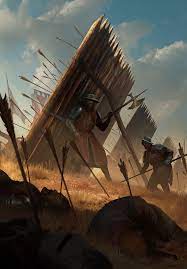Key Point: A Mantlet shield was a portable protective barrier or shield used by soldiers in medieval warfare to provide cover from projectiles, such as arrows and bolts.
Here we will discuss the Mantlet. This portable shield was used through centuries to protect soldiers from arrow fire while they were storming the castle. You will see, the history of the Mantlet. How it was used, and how effective the Mantlet was really.
And of course, you get to see why it stopped being used. Now before we continue, let’s first examine what it was. So, what is a Mantlet?
A Mantlet was a type of portable shield that soldiers used to protect themselves from enemy fire. Made of wood or metal, it could be positioned by a team of soldiers and had a small opening or slit to allow archers or other ranged combatants to fire from behind the shield. Mantlets were primarily used in siege warfare to provide cover for soldiers approaching enemy fortifications.
Sounds simple, right? A portable shield protecting the soldiers attacking a castle that is under siege. Now, let’s take a look at the history and the origins of the Mantlet.
History And Origin Of The Mantlet
The use of a Mantlet in warfare can be traced back to ancient times. With examples found in the battle tactics of many civilizations throughout history. If you are a fan of history, you know what civilization I’m mentioning next. The Greeks, of course.
The ancient Greeks, for instance, used a wooden screen (a Mantlet) to protect their archers from enemy fire.
However, it was during the medieval period that the Mantlet really came into its own. Back then, a Mantlet was typically made of wood. Some models were reinforced with metal. Here is how it was used: Mantlet was moved into position by a team of soldiers and provided valuable protection for troops as they approached enemy fortifications during siege warfare.
The Mantlet Was Not Only Used In Sieges
In open-field battles, Mantlets were used by archers and crossbowmen to provide cover as they fired upon enemy positions. The use of a Mantlet for protection declined as technology progressed and other forms of portable protection emerged, such as the pavise shield.
Now, you might be thinking: What’s the difference between a pavise and a Mantlet? Well …
Mantlet Vs. Pavise
The main difference between a Mantlet and a Pavise is that the Pavise is much more fortified than the Mantlet. Also, the Mantlet was used in siege warfare and sometimes in open battles while the Pavise was used mainly in open battles.
Here Is How The Mantlet Was Used

The Mantlet was typically used by soldiers in siege warfare as they advanced toward enemy fortifications. Teams of soldiers would move a Mantlet into position, providing cover for their comrades as they approached the walls of a castle or other fortified structure.
The premise is simple. Move the Mantlet in front of the besieging city or castle. The shield would give attacking soldiers cover from most projectiles.
A Mantlet was also used by archers and crossbowmen in open-field battles. Where they provided temporary cover as they fired upon enemy positions. The lightweight design of the Mantlet allowed soldiers to move quickly and easily on the battlefield. While still providing a measure of protection from enemy fire. Overall, the Mantlet was a versatile and important tool for soldiers throughout history, providing valuable portable protection in a variety of different combat situations.
The 4 Disadvantages Of The Mantlet
- Size and weight While the Mantlet was designed to be portable and easy to move, it could still be cumbersome and difficult to transport, particularly over long distances or rough terrain.
- Fragility The Mantlet was relatively fragile compared to other forms of portable protection, such as the pavise shield. It could be vulnerable to heavier artillery fire or melee weapons such as swords and spears.
- Limited protection The Mantlet provided protection only from one side, leaving the soldiers vulnerable from other directions. And, the soldiers manning the Mantlets had limited visibility. This made it hard for them to identify and respond to threats from multiple directions.
- Difficulty of use Mantlets required a team of soldiers to move and position them, which could be challenging in the chaos of battle. Additionally, the soldiers manning the Mantlets needed to be trained in their proper use and tactics, which could take time and resources to develop.
Why Did The Mantlet Fell Out Of Use?
The Mantlet stopped being used on the battlefield because gunpowder weapons made light, portable shields obsolete. As you can imagine, having a small wooden shield go against a gunpowder firearm (even the early ones) is not good. That is putting it lightly.
So, as firearms got more developed wooden shields became ineffective. This put an end to Mantlet use after centuries, even thousands of years (if we take into account the Ancient Greeks).
In Conclusion
Thank you for taking the time to read this article on the Mantlet. I hope you learned a thing or two. And if you wish to continue learning about siege weapons I suggest you take a look at my article where I compare the effectiveness of a siege tower to a battering ram right here.
Or continue learning about siege warfare by taking a look at the Great Turkish Bombard. A truly massive siege weapon that played a pivotal role in sieges throughout history. Like the fall of Constantinople in 1453. Click here to see an article on this historical siege weapon.
Take care!